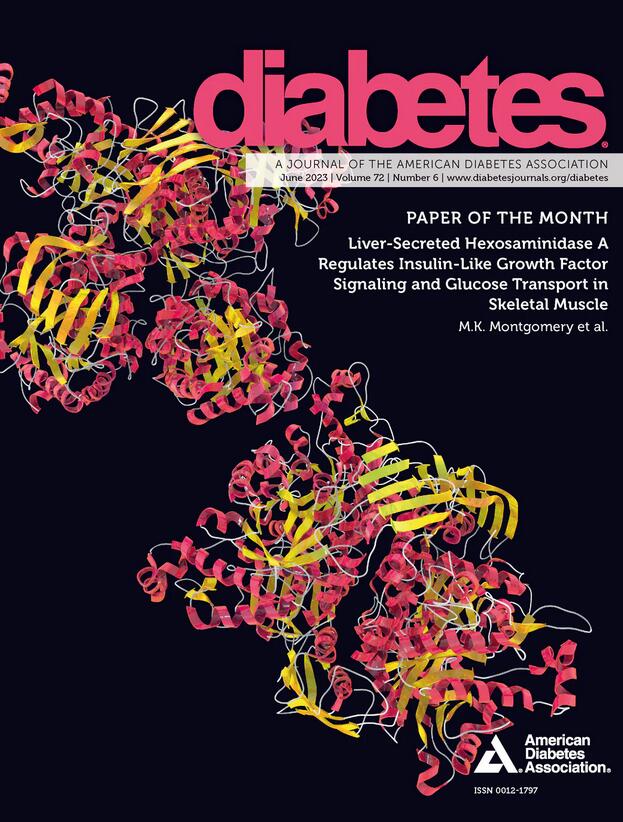1804-P: Beta-Cell Loss with Severe Hyperglycemia Is Responsible for Augmented Notch 1 Expression in the Pancreatic Exocrine Ductal Cells
IF 7.5
1区 医学
Q1 ENDOCRINOLOGY & METABOLISM
引用次数: 0
Abstract
Introduction and Objective: Functional crosstalk between pancreatic islets and exocrine pancreatic tissue may be a determining factor in the progression of type 1 diabetes (T1D). Supporting this premise, we found that inhibition of serpinB13, an inhibitor of cathepsin L (catL) proteinase expressed in the exocrine pancreatic ductal cells, has positive outcomes in T1D. We also found that cleavage of Notch1 (a gatekeeper of β-cell development) following inhibition of serpinB13 with a monoclonal antibody (mAb), is a key molecular event that connects endocrine and exocrine tissue in the pancreas. Based on our observations, we hypothesized that the Notch1 receptor is expressed in the pancreatic ductal tree. Methods: To examine this, we induced β-cell-specific ablation with diphtheria toxin (DT) in InsCre/Rosa26iDTR transgenic mice, which were treated with a wild-type islet transplant or left untreated and sacrificed for pancreatic examination 2 weeks after diabetes induction. To assess Notch1 in the pancreas we used Western blot and IF microscopy with the Visiopharm software. Results: Both methods revealed that severe insulin-dependent diabetes results in marked augmentation of Notch1 expression (p<0.0001 and p=0.0054, respectively). The marked increase in the Notch1 protein level was specific, as expression of presenilins (which are required for processing of Notch1) was intact. We also found that islet transplantation preventing hyperglycemia in DT-treated animals completely blocked Notch1 upregulation. Finally, histological analysis revealed that Notch1 expression is confined to the cytokeratin-19+ epithelial cells in the exocrine ducts. Conclusion: We conclude that high Notch1 expression in the exocrine pancreas may explain its regulation by serpinB13. Moreover, our results demonstarte that hyperglycemia, rather than direct sensing of β-cell loss by the exocrine pancreas, is responsible for Notch upregulation in ductal epithelium. Disclosure Y. Kryvalap: None. R. Habte: None. S.Z. Meng: None. J. Czyzyk: None.1804-P:严重高血糖的β细胞损失是胰腺外分泌导管细胞Notch 1表达增加的原因
简介与目的:胰岛和外分泌胰腺组织之间的功能串扰可能是1型糖尿病(T1D)进展的决定性因素。支持这一前提,我们发现抑制serpinB13(一种在外分泌胰腺导管细胞中表达的组织蛋白酶L (catL)蛋白酶抑制剂)在T1D中具有积极的结果。我们还发现,单克隆抗体(mAb)抑制serpinB13后,Notch1 (β细胞发育的看门人)的切割是连接胰腺内分泌和外分泌组织的关键分子事件。根据我们的观察,我们假设Notch1受体在胰腺导管树中表达。方法:为了验证这一点,我们用白喉毒素(DT)诱导InsCre/Rosa26iDTR转基因小鼠β细胞特异性消融,这些小鼠在糖尿病诱导后2周接受野生型胰岛移植或不治疗,并处死进行胰腺检查。为了评估胰腺中的Notch1,我们使用了Western blot和IF显微镜以及Visiopharm软件。结果:两种方法均显示严重胰岛素依赖型糖尿病导致Notch1表达显著增加(p<;0.0001和p=0.0054)。Notch1蛋白水平的显著增加是特异性的,因为早老素(Notch1加工所需的)的表达是完整的。我们还发现,胰岛移植可以预防dt治疗动物的高血糖,完全阻断Notch1的上调。最后,组织学分析显示Notch1的表达仅限于外分泌管的细胞角蛋白-19+上皮细胞。结论:胰腺外分泌区Notch1的高表达可能解释了serpinB13对Notch1的调控作用。此外,我们的研究结果表明,高血糖而不是外分泌胰腺直接感知β细胞损失,是导管上皮Notch上调的原因。克雷瓦莱普:没有。R. Habte:没有。S.Z. b孟:没有。J. Czyzyk:没有。
本文章由计算机程序翻译,如有差异,请以英文原文为准。
求助全文
约1分钟内获得全文
求助全文
来源期刊

Diabetes
医学-内分泌学与代谢
CiteScore
12.50
自引率
2.60%
发文量
1968
审稿时长
1 months
期刊介绍:
Diabetes is a scientific journal that publishes original research exploring the physiological and pathophysiological aspects of diabetes mellitus. We encourage submissions of manuscripts pertaining to laboratory, animal, or human research, covering a wide range of topics. Our primary focus is on investigative reports investigating various aspects such as the development and progression of diabetes, along with its associated complications. We also welcome studies delving into normal and pathological pancreatic islet function and intermediary metabolism, as well as exploring the mechanisms of drug and hormone action from a pharmacological perspective. Additionally, we encourage submissions that delve into the biochemical and molecular aspects of both normal and abnormal biological processes.
However, it is important to note that we do not publish studies relating to diabetes education or the application of accepted therapeutic and diagnostic approaches to patients with diabetes mellitus. Our aim is to provide a platform for research that contributes to advancing our understanding of the underlying mechanisms and processes of diabetes.
 求助内容:
求助内容: 应助结果提醒方式:
应助结果提醒方式:


